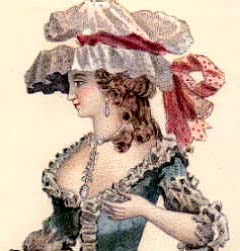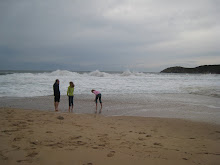Most mornings during the week the dogs and I walk up to Chateauneuf. We go out of our portail and then turn directly up the hill, and walk up a steep path that used, several decades ago by the looks of it, to be a paved road. There are bits of asphalt and large stones and pebbles, and leaves and acorns and sticks, and the path turns a few times as it climbs the hill. I let the dogs go up and, later, down, without wearing their leashes: all three of us need to watch our footing. Visitors tend to take this path with me exactly once, and then decide that another walk, along the road or across to Opio, will suit better.
But Wendy and Alice and I like this walk. We come out of the path in front of the LaChaix' portail onto their driveway, and that's when the dogs have to put on their leashes. There's asphalt, then, a proper paved road, wider than my arm span, and it continues uphill, with a tall stone wall on the left and a drop down into olive groves on the right. When we come out of Jules' driveway, the road gets a name: the chemin du Moulin. The moulin in question is on the left, but it's a long time since it milled anything besides fancy parties in the summer time when the owners are in residence.
The lane is flatter, now, and the views begin. Just in front of us, occupying the north-eastern horizon, is the Pic de Courmettes, the mountain at the mouth of the Loup river. When the lane turns a little left, following the lines of the hillside, we can see Chateauneuf in front of us, on top of the next hill. It is a proper hill town, with the church tower in the center at the highest point, and tall houses encircling it, descending the hill until they meet the olive trees coming up. Beyond Chateauneuf, more mountains, and on days after it has rained on us, there's snow on the tops of those mountains.
Some mornings our walk coincides with the morning jaunt of the sheep that live nearby. We can hear their bells clanging down at the bottom of the terraces, where the hill we're on stops and the village's hill begins. I can, if I slow down and look, sometimes see the sheep through the olive trees, but it's not easy. They camouflage, these sheep; they've evolved perfectly to fit their surroundings, with wool the same color as the olive bark in the sunshine and as the stones holding up the terraces.
One morning a week or so ago the sheep's bells sounded louder and closer. We came around a curve and I saw them: they were on the terrace directly beneath the road. It was a spot where there is wall on one side and, on the other, a straight drop of several yards, to a terrace and, then, another drop to the next terrace. The sheep were a few lengths of leash away from us.
Alice and Wendy smelled them before they saw them, of course; they always do smell them, but rarely see them, dog senses being what they are. This time they saw, and both of them stood up and walked along on their hind legs like trained bears at the circus. Their noses and whiskers were working overtime as they breathed it all in. They didn't bark; I think they were too surprised. Words failed them.
When I came around a cedar tree, I saw the shepherd. He was a Hollywood shepherd. He could have been 50 or 80: his face had that leathered thick look that men here who work outside in the sun all year acquire. He was compact but sturdy, wearing several warm shirts in assorted plaids and patterns, all buttoned up against the morning chill; sturdy work pants; boots; a cap. Here is what made me look twice: he was leaning on a crook. I've never seen anyone use a crook, besides bishops, or the Marx Brothers in a crackly old vaudeville routine. I think I had never thought about a crook being more than a prop, something whose original use had long since fallen away, and remained as a metaphor (for a bishop) or a joke (for Groucho).
Our shepherd was standing, legs braced, with both hands folded on the top of his crook, and his chin resting on his hands. He was standing so still that I doubted myself. I thought that maybe my imagination was getting carried away with the surroundings and starting to embroider a bit; maybe I needed to switch from tea to coffee in the mornings. So I spoke to the shepherd.
Bonjour, monsieur. It's very exciting for the dogs to see the sheep. It's difficult to be pithy when you are testing a hallucination.
He jumped, startled, and waved his crook a little in the air. He smiled broadly, the smile of a man who has not stood in the lavendar x-ray machine. Et bonjour, madame, bien sur! and then something in an accent so thick and with the words pouring out so fast that all I could do was smile and nod and continue on my way.
The sheep were gone when we came back from our trip to the village, and, while I've seen the sheep since, I haven't seen the shepherd. I wonder if he got a call from his agent, and has gone off to play the role of Provencal Shepherd in the next Spielberg movie. Wendy and Alice would be happy to fill in while he's gone.
skip to main |
skip to sidebar
































An American family in southern France





- Madame Marron...
- is my nom de clavier. I am an American woman living en famille--husband, daughters, and dogs--at a house called La Bastiole, down the hill from a village in southern France. A long time ago and several time zones away, I earned a doctorate in French history. Then I was a curator of the American collection at a museum of decorative arts. Then I moved to France. Et voilà: here we are.

Email Mme Marron

Labels
- At home (20)
- At school (16)
- Driving in France (9)
- In the Garden (10)
- In the Kitchen (14)
- In the Village (53)
- Living in France (51)
- mère de famille (37)
- speaking French (33)
- Travelling (24)
- Visitors (11)
















Expats en plus
- 'Allo Expat France
- A Dress a Day
- AMB Côte d'Azur
- Americans in France
- An American in Avignon
- Blogs by Women
- BurkinaMom in France
- Chez Loulou
- Chitlins and Camembert
- Chocolate & Zucchini
- Deep Quercy
- Dooce
- Expat blog
- Expat Women
- French Word-a-Day
- Halfway to France
- La France profonde
- Little Hunting Creek
- Living the Life in Saint-Aignan
- Meanwhile here in France
- Motherlode
- Not waving but drowning
- Paris Daily Photo
- Petite Anglaise
- Provence from Fayence Outwards...
- soupe du jour
- Tartelette
- Tea and Cookies
- The Elmo Wallpaper
- The Provence Post
- This French Life
- This Provençal Life
- Three Continent Family















No comments:
Post a Comment